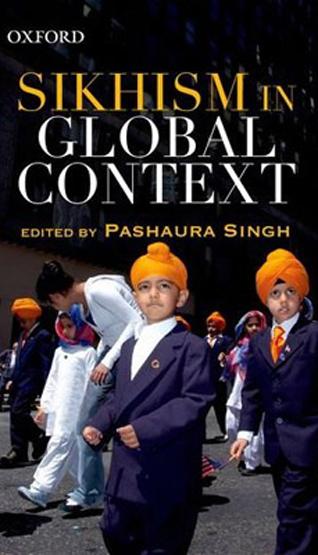Books
Sikhism in Global Context
A Book of Essays Edited by Dr. Pashaura Singh
A Book Review by SARAN SINGH
SIKHISM IN GLOBAL CONTEXT, Edited by Dr. Pashaura Singh. Oxford University Press, 2012,. Hardback, 304 pp. ISBN-13: 9780198075547, ISBN-10: 0198075545 Hardback, 304 pages. $55.00.
This latest work on Sikhism is an exquisitely conceived anthology of a
dozen essays by some of the most perceptive contemporary sociologists and
historians - Western as well as subcontinenal, the outcome of a University of
California seminar. The contributors are among the best known living scholars
of Philosophy and Comparative Religious Studies and Sociology.
Consequently, the reader of this anthology has the advantage of starting any one essay, and going back and forth, according to his (or her) choice.
Within its covers, women scholars rub shoulders with men;
European and American analysts share space with writers of origin in the subcontinent.
The 'cocktail' therefore imparts a refreshing elan to the volume.
This is, besides, a welcome contribution to a study of the Sikh
philosophy and faith that has, more often than not, been inadequately
understood and - at times - misunderstood, 'hedged in' as it is
between Hinduism and Islam, in the context of the turbulent history of India, as well as [and, particularly] the titanic events
of the 19th and 20th centuries, right up to the Partition
in 1947 of Punjab and the subcontinent.
Some history scholars generally dismiss
Sikhism as a pan-Hindu 'reformist' movement, or simply, one more
instance of syncretism within the sub-continental context. Few scholars
care to or show interest in delving deep into its theology or
history. Among exceptions are the late Dr Hari Ram Gupta (of pre-Partition days, from Forman Christian College, Lahore) and Bengal's highly
regarded scholar, Prof. Emeritus Himadri Banerjee of Jadavpur
University, as also, Dr. Chhanda Chaterjee of Viswa Bharti.
It is a
joy to find, for example, an illuminating research paper (Chapter 9) by Prof. Banerjee
on "The Sikhs of Shillong" - whom the community seems to have
all but forgotten.
This timely publication, therefore, needs to be pondered - not only by
students of History, but also by those who claim to represent Sikhs
globally. A majority of historians of India remains preoccupied with the
epochal Mughal dynasty, and tend to bypass - or trivialize - the profound
impact of Guru Nanak and the nine succeeding
Gurus.
Significantly, however, the course of Sikh history [Guru Nanak to
Guru Guru Gobind Singh, 1469 to 1708] is coterminous with the span of
Mughal dynasty [1526-1707]. Emperor Akbar briefly visited Goindwal (near
Amritsar). Indeed, he typically gifted the 'Parganas' that
the Fourth Guru setup as Chak Ram Das Pur, the present Amritsar.
Upon Akbar's demise the tragic irony of the Fifth Guru Arjan being charged
wth sheltering Jahangir's rebellious son, Khusro, and in the
summer of 1606, being tortured to death at Lahore!
In a sequel, Jahangjr tried
to win over Guru Hargobind, the Sixth Guru (1595-1644). Tragically,
however, Aurangzeb's zealous policy to convert Kashmiri Pandits
to Islam brought the Ninth Guru Teg Bahadar to Delhi to plead their defence with the
Emperor - only to be put to the sword in Chandni Chowk in
November 1675.
Aurangzeb later travelled to the Deccan to quell the Maratha uprising. He
died at Aurangabad in 1707 - but not before he had received from Guru
Gobind Singh a letter of protest in Farsi, captioned "Zafarnama",
symbolizing the Guru's moral victory!
Much of this is objectively reflected in Professor N. Gerald Barrier's
opening essay - which also embodies a touching eulogy of the pioneering
historian, late W.H. Mcleod (who died on 24 July, 2009).
Prof Pashaura Singh's Introduction and Nikki Guninder Kaur Singh's article on Guru Granth Sahib are insightful as well as analytical, dwelling on Sikhism's theology, social content and aesthetics.
Western Scholars' perceptions
are discussed - lucidly, if critically - by Doris R. Jakobsh. She aptly highlights Sikhism's credal rejection of Hinduism's unsociability and
caste-based apartheid!
More interesting (and topical) for the lay reader is Paul Wallace's essay
on "Militancy and Non-Violence" - the latter aspect in the
context of the struggle ("morcha") for the liberation of historical
Sikh shrines, and the frenetic struggle for 'Punjabi Suba'.
The Editor himself - Prof Pashaura Singh - writes a scholarly and insightful essay on the Chaunkies at Darbar Sahib.
Our favourite is Susan E Prill's essay on Naam - "The True Name, and its Miraculous Manifestations".
Dr Jasjit
Singh Walia of the University of Louisiana, has narrated the
"Miracle of Guru Granth Sahib" in the wake of 'Hurricane
Katrina' in 2008. Chapter 5 on the "Kirtan Tradition at Darbar Sahib" and Chapter 6 on 'Miracles" make fascinating reading in terms both of
facts as well as interpretation.
The Chapter on Diaspora Philanthropy discusses the desire of the Sikhs of the diaspora
to improve - even transform - the Punjab rural scene on an extraordinary
scale, a sentiment that derives from Sikhism's daswandh tradition - of
giving away tenth of
one's earnings for public welfare.
In so far as Indian Constitution provides special treatment of Scheduled
Castes, there has been a raging dichotomy among Sikhism's own marginalized groups - Ravidasis, Valmikis, and others - a
problem analyzed and amplified in an essay by Opinderjit Kaur Takhar.
In another genre is Prof. Himadri Baherjee's essay, The Other Sikhs", on those living in poverty on the margins of society.
Both
these Chapters deserve to be studied in depth, especially by those who
control the Shiromani Gurdwara Prabandhak Committee in distant
Amritsar!
The Tenth and Eleventh Essays - "Gurbani Kirtan" and "Home
and the World" - are in-depth social studies in the traditional Sikh
art of Kirtan, or devotional singing of the scriptural gubani that
transcends space, time and vicissitudes.
The concluding essay on
Children's literature (and identity) is rightly reflected in the book's
jacket - as also in the more recent "Sikh Comics" series
published by Gyan Khand Media of Sangrur, Punjab.
Altogether, the Anthology marks a milestone in Sikh Studies
world-wide.
The author of this book review is the Editor of The Sikh Review.
[Courtesy: The Sikh Review. Edited for sikhchic.com]
February 4, 2012
Conversation about this article
1: Baldev Singh (Bradford, United Kingdom), February 04, 2012, 12:38 PM.
This book deals with some serious and powerful issues in Sikhism today.
2: Pashaura Singh (Riverside, California,,U.S.A.), February 04, 2012, 9:19 PM.
My heartfelt thanks to S. Saran Singh for doing the review in The Sikh Review. The growth in Sikh studies worldwide has led to greater attention to Sikh history and culture in recent times. Written in honor of W.H. McLeod and N. Gerald Barrier, two pioneers of Sikh studies, this book goes beyond the usual studies of Sikh philosophy and religious practice. The essays explore Sikh historiography, identity, music and ethics, the Sikh diaspora, and the history and the current state of scholarship in the area of Sikh studies. They represent a diverse range of theoretical and methodological approaches to the study of Sikhism, including religious studies, historical studies, anthropology, sociology, gender and ethnic studies, ethnomusicology, diaspora studies, and ritual and performance studies. They also analyze how local experiences confirm yet complicate notions of global and/or diasporic Sikh belief and practice. This book will be of considerable interest to scholars and students of Sikh studies, history, religion and diaspora studies, as well as general readers.
3: Dhanwant Singh (Calgary, Alberta, Canada), February 06, 2012, 6:11 PM.
Dr. Pashaura Singh, keep up good work and remain in chardi kalaa. Wish you the very best and pray that you continue your service to Sikhi.
4: Ardaman Singh (Franklin Park, New Jersey, U.S.A.), February 10, 2012, 9:31 AM.
This is my son on the cover page :-) Dayaal Singh (wearing the patka) at the Vaisakhi Day Parade in New York City. How can I get a copy of this book?
5: Pashaura Singh (Riverside, California, U.S.A.), February 10, 2012, 11:26 AM.
Thanks, Ardaman Singh ji, for identifying the photograph of your son, Dayaal Singh, in the jacket visual. This is courtesy of Richard Levine/Alamy/India picture, who took the snapshot of "members of the Sikh Religion from New York and all over the Eastern Seaboard march in the Sikh Day Parade in NYC." You are a lucky father to see the photograph of your son on the cover of an Oxford publication. I am sure the parents of other boys and girls will also come forward to identify their children. This photograph actually won the competition for three possible cover designs created by the Oxford University Press. I had sent three photographs of different events (particularly the opening of the new building of the San Jose Gurdwara), but my photographs could not stand against this final design. Congratulations to you and your son. You can get this book from Amazon.com or directly from the Oxford University Press, U.S.A. or their New Delhi store in Darya Ganj. South Asia Books (sabooks@juno.com) can also provide you the book in the U.S.




